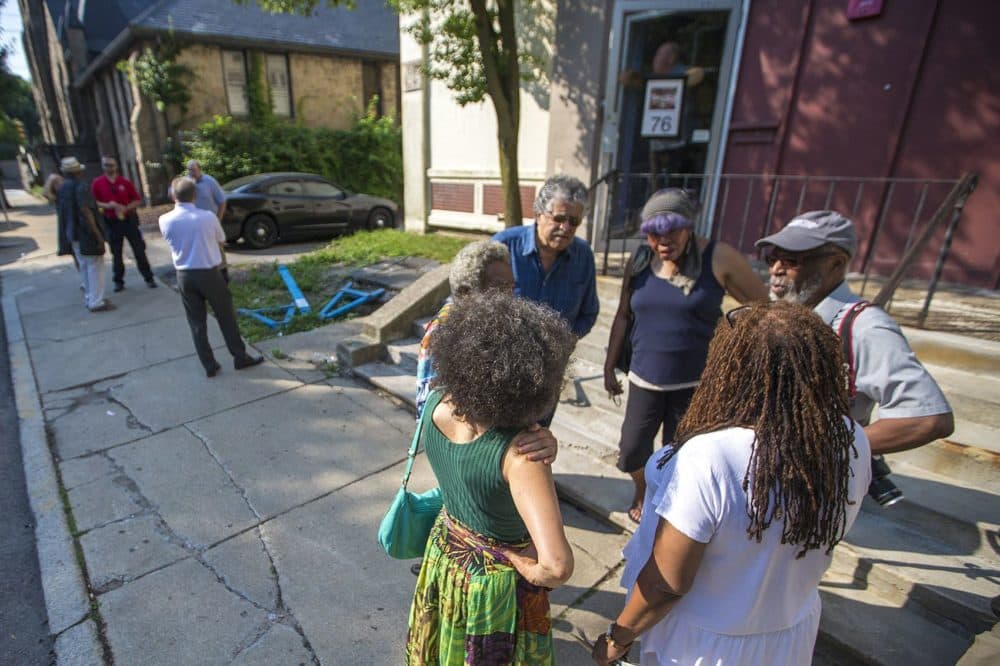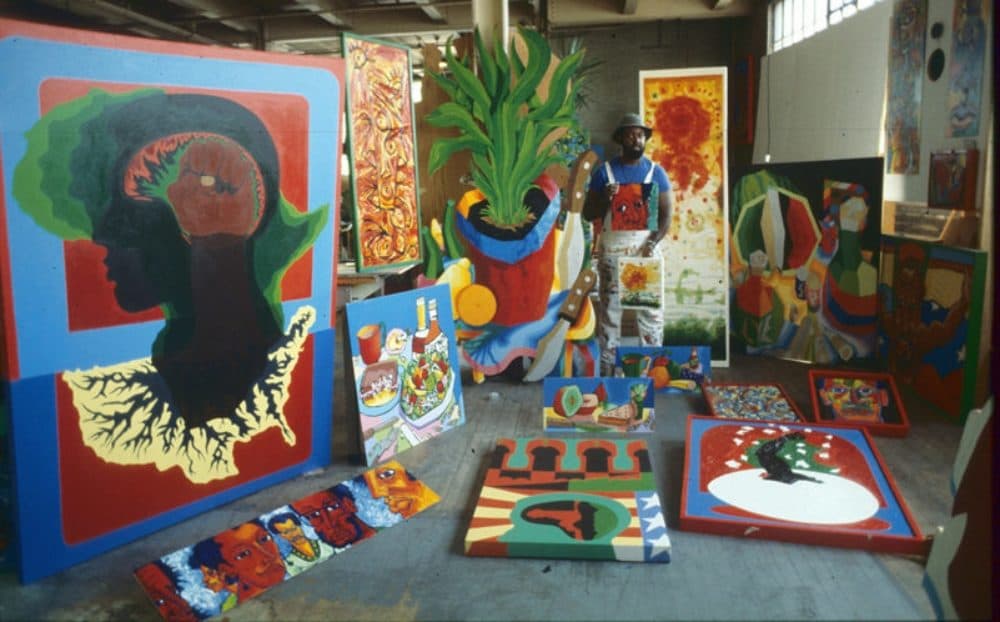Advertisement
Tensions Between Black Artist Program And Northeastern Go Back Decades

On a leafy residential street in Jamaica Plain, a vast industrial building that once hummed with creative energy is emptying.
For nearly 30 years, the building has been home to Northeastern University's African-American Master Artists-in-Residence Program, or AAMARP. The future of that program is now uncertain.
The artist collective has until Oct. 31 to vacate its studios, an extension that was granted after the city stepped in last month with an offer to mediate. The university had originally ordered the group to leave by July 13. The two parties declined to comment for this story while they negotiated.
The university has said the artists group — which occupies a university-owned building free of charge — has made the building hazardous.
But AAMARP founder Dana Chandler says the university has neglected the space at 76 Atherton St. in Jamaica Plain, and the program that he founded 40 years ago.
“If you read some of the ... letters sent to us by the university, they act like they just suddenly discovered we were there and they're wondering, ‘How in the heck did these these people get in our spaces?’,” Chandler says. “So they don't know their own history.”
The seeds of AAMARP were planted in 1973 when Chandler, an artist and activist, came home from a trip to discover that his Boston studio had been vandalized and much of his work lost. Northeastern University came to his aid, hiring him as an artist-in-residence and eventually granting him a portion of a 40,000 square-foot space at 11 Leon St. in Roxbury for use as a studio. The building was so large, Chandler says, that he wondered if it might be made available to other artists.

He especially wanted to support African-American creatives, who he felt had been shut out of the art world in Boston.
“I used to go back to the Museum of Fine Arts from the time I was about 8 years old,” Chandler says. “And whenever I went in there, of course the guides would follow me around because they were convinced that I was going to mess up some of the art some kind of way. Because they didn't believe a little black kid would understand where he was.”
The African-American Master Artists-in-Residence Program was unique from the beginning. In addition to offering space to artists rent-free, residencies were three years long with the opportunity to renew; some artists stayed with the program for decades. The original roster of 13 artists included the painter Ellen Banks and the multimedia artist and educator Calvin Burnett, who taught at Massachusetts College of Art for 33 years.
Chandler describes an “organic” approach to programming that emphasized community access to living artists. “I always put out information to the community at large that any school ... could have the students come and watch us work,” the artist says. “People wander[ed] in off the street to see what [was] going on.”
Advertisement
Chandler says that during his tenure the program exhibited work by prominent black artists Benny Andrews and John Wilson. The space, he says, was used for other events as well, including theatrical productions.
But Chandler’s relationship with the university was also contentious. Though he found an ally in Ken Ryder, who served as president of Northeastern from 1975 to 1989, the artist was critical of what he saw as racism on the part of the university. He felt that the campus was hostile to blacks, that the faculty was becoming less diverse and that the university was more concerned with expanding its facilities than with supporting programs like AAMARP.
“I don't really feel the universities of this country really want people of color on their grounds. They simply don't allow us to do on those campuses what we're capable of doing,” Chandler says. “They allow us to do the things that they think are appropriate to whatever their philosophy happens to be in any given time. And the philosophy of people of color may be very different from what the university wants expressed as a part of their educational process.”
In 1991 Northeastern cut AAMARP’s budget, making Chandler part-time, and in 1993 eliminated his paid director position as part of university-wide budget cuts and downsizing. (Chandler remained in Boston as a tenured professor at Simmons College until 2004, during which time he maintained a studio space at AAMARP. Now 77, he is retired and lives in New Mexico.) The early '90s saw the purchase of several new university properties, among them the Atherton warehouse that AAMARP would move into.
In a letter concerning the move to that warehouse, Northeastern’s Dean of Physical Planning and Design assured Chandler that the Atherton space would be “finished, maintained, and secured to a standard equivalent to other Northeastern buildings.”
But Chandler says that the renovations were far inferior to Northeastern’s standards. When the university acquired the 29,000 square-foot space, it was largely unfinished, Chandler says, and required “cosmetic” changes, including sheetrock walls to create rooms. “That never happened,” Chandler says. “So the artists in the program … made a space for themselves.”
A letter in June of this year from Northeastern to AAMARP cited “‘false walls’ of wood and flammable materials” among the university’s safety concerns.
The university also pointed to rerouted plumbing and evidence that people may have been using the studios as living spaces as reasons for ordering the program to vacate the building, which it said required upgrades and repairs.
AAMARP operates under the auspices of the Department of Cultures, Societies and Global Studies, which includes the Program of African-American Studies. Department chair José F. Buscaglia said that the department furnishes a “modest” budget for the program’s operational costs and sponsors its open studios.
In a July 9 letter to AAMARP artist Gloretta Baynes, Northeastern affirmed its intention to “continue … ongoing discussions geared toward strengthening, expanding and reimagining our historic partnership,” but stopped short of making an explicit commitment. The artists have a little over two months to vacate the space.
